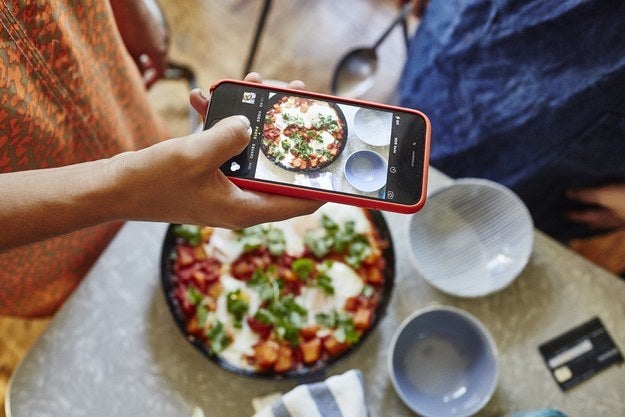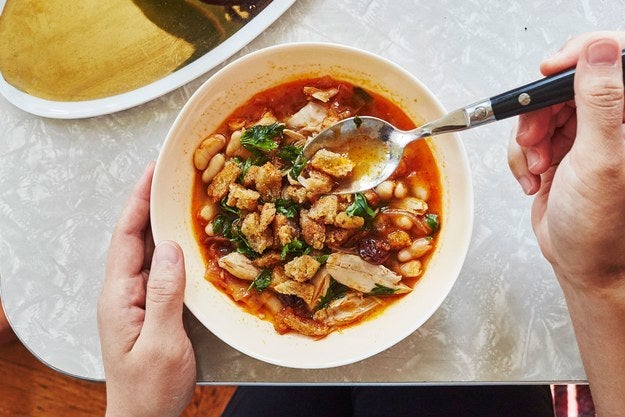For Bon Appetit, by Alyse Whitney.

Resolutions have never been my strong point. Every year, I make a pact with myself to try something new or get rid of a bad habit, but then, you know, life gets in the way. But 2017 is going to be different, because after one alarming spreadsheet of my spending habits, I realized my budget needs a complete overhaul.
This is not an easy task, especially living in expensive New York City and working atBon Appétit, where I’m constantly hearing about new restaurants and wanting to cook intricate recipes that our test kitchen develops. A hefty part of my income goes to dining out, buying something overpriced at the cafeteria when I forget my lunch, and grocery shopping. Cooking at home can cut down on costs, but being single means that you are eating leftovers all week. And after that fourth serving of chili, I want to throw the bowl at the wall. Food isn’t the only thing I’m spending on, of course — but talking about my Uber habits and mild hoarding is for another day — but it does happen to be the center of my personal and professional lives.
As we head into the new year, I’m armed with a food lovers’ game plan to save money and eat well in 2017. That includes learning to love canned beans as much as a roasted pork shoulder, cold-brewing at home, and mildly-extreme couponing. Clear eyes, full wallets, can’t lose.
Set Realistic Goals

Going cold turkey isn’t the way to fix your budget. If you’re spending hundreds on dining out every month, try to shave it down by a manageable amount—like 10 or 20 percent, aka $10-$20 for every $100—to start. But before you start hacking away at your spending, ask yourself about your relationship with food, suggests Kimmie Greene, consumer finance expert for Mint. “Do you cook? Do you order in and let your stove collect dust? Do you entertain? Have a dialogue with yourself upfront tooutline a smarter, more realistic budget.” Once you have that information in mind, take an audit of your current spending — how many times you buy groceries per month and how much it costs, plus how much you spend dining out — and then re-visit that every three months to account for changes. You should set weekly and monthly budgets, but not daily numbers to hit — things fluctuate, especially when you buy items that last for many meals, like rice or a half-gallon of milk. “Tracking each meal would be really hard, like attempting to count every calorie,” Greene points out. “Don’t do things that cause you more frustration than budget benefits.”
Meal Prep Work, Work, Work, Work, Work, Work
Dedicating one day to cooking for the week will keep you from making excuses. After work, finding time to go the gym, walk my dog, and do laundry is hard enough — adding cooking at night is nearly impossible. Save any big-batch cooking and longer projects for the weekend — like slow-braised meats, roasted vegetables, pots of beans and grains, and soups and stews — and try to make more than one meal so you don’t get bored. Utilizing a slow cooker (or cult-favorite Instant Pot) to make a few pounds of pork shoulder that can be repurposed into a slew of dishes throughout the week is my first order of business. It can be taco bowled, a lunch salad topper, BBQ-sauced for a sandwich, tossed in a soup, or simmered in a ragú. That’s an ambitious weekly menu, but it’s less daunting when you can eat it over the course of a few weeks...
The Freezer Is Your Secret Weapon
Five uses of pork in one week isn’t realistic. It can be done, but pigging out for that long may give you the meat sweats. Instead, portion out a half pound or so in freezer bags, date ‘em, and save them for later uses. You can either just freeze the meat to repurpose or save single-serving dishes for quick, microwavable meals later. Budget Bytes blogger Beth Moncel suggests doing “big batches of soup, chili, or pasta for variety or when you’re too tired to cook.” This also goes for raw meat — buy chicken thighs when they’re on sale and use them for soy-citrus chicken skewers instead of ordering take-out in a few weeks.
Stock Your Pantry
My pantry is cluttered with random things like Trader Joe’s impulse buys and assorted jams, so it’s obviously in desperate need of an overhaul. My first order of business was organizing everything into jars — and labeling them with a Brother label-maker that printed gold text and felt a little fancy — so I knew exactly what was in there. Once you know what ingredients you’re working with, it’s easier to plan meals for the week ahead (and not accidentally double-buy at the store). Rice, quinoa, lentils, pasta, farro, and other whole grains will all work as easy bases for dishes, and they can be flavored and enhanced with Bon App’s pantry staples. Moncel also suggests using a lot of oatmeal and beans, two things that I’m going to try to teach myself how to love in 2017.
Bulk Up With Cheap Ingredients

Speaking of beans, Moncel says one surefire way to cut the cost and bulk up the nutrients is by substituting half the meat in a dish with beans. Moncel suggestsblack beans to get a similar texture and color while adding protein. This won’t work for a roast chicken, but for stir-fries and ground meat dishes, beans are an easy sub-in. And while we’re talking about beans, dried is cheaper overall, but weigh the time and effort put into buying dried vs. canned. If you won’t give yourself time to soak and cook your beans — between 1-3 hours, unless you have a pressure cooker — then spending a little more on a can will ultimately save you. At BA, we like canned cannellinis, navy, chickpeas, and black beans.
Waste Not, Want Not
Captain Planet-approved tip: Don’t let your food go to waste! Instead of letting things go bad in your crisper drawer, use almost-wilted vegetables in a stir fry and blitz up a bunch of miscellaneous herbs into an exciting herb jam or pesto. And most importantly, melt all the cheese orphans in your fridge into a bowl of fondue or an epic grilled cheese — it’s never a bad idea.
Mildly-Extreme Couponing
Overall, it also helps to do a price comparison on different brands, no matter what the item is. I’ve been using the Flipp app — which shows weekly flyers for most major grocery stores, lets you make a list, and shares coupons — but going the old-fashioned route and clipping coupons couldn’t hurt, either. There’s also Cartwheel for Target, an app that allows you to pre-save coupons or scan them directly from your phone in the store to check if they’re on sale. If you liked playing at fake grocery stores as a kid, this is a similar kind of fun. It may seem like a total “duh” moment, but make a meal plan and grocery list before you go out and try to stick to it — the impulse buys are what’ll throw your budget out of whack.
Allow Yourself to Cheat a Little
Even if you somehow follow all these steps, you’re probably going to mess up. That’s why you build in a fail-safe so if you “forget” your lunch one day or desperately need an afternoon coffee, you won’t stress out. “Treat yourself now and then so you’re more satisfied and less likely to go and buy food,” Moncel suggests. One way I’m keeping myself in check is starting a lunch swap with some work friends. We’ll each bring in a dish of our weekly meal prep and swap tupperwares so we don’t get sick of our leftovers. I’m also making my favorite mulled-spice cold brew at home, to save $4 a day. Ultimately, I may not be able to do all of these things right away, but starting small — like setting a budget and making time for meal prep — is my first goal. From there, it’s about making the process fun and not stressful, which can be done by singing and dancing in the kitchen while slow-cooking pork shoulder.
More from Bon Appetit:
